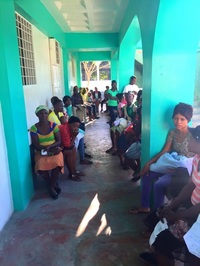Our clinic was located about 3 miles away from Blanchard (where we stayed) in Cite Solei, an extremely impoverished and densely populated commune located in the Port-au-Prince metropolitan area in Haiti. The area is generally regarded as one of the poorest and most dangerous areas of the Western Hemisphere and it is one of the biggest slums in the Northern Hemisphere. The area has virtually no sewers and has a poorly maintained open canal system that serves as its sewage system. It has few formal businesses but many local commercial activities and enterprises. There is sporadic but largely free electricity, a few hospitals, and two government schools. HOM operates this clinic along with a church and school on the same site.
As I mentioned in an earlier post, we were not allowed to tour Cite Solei this year as we have in the past because of violence in the city while we were there. Therefore I’m sharing some of my friend Frank Clark’s pictures from their tour of the city in 2015 in a slideshow below. (Thanks Frank!) Since I was not able to see the city for myself (beyond the clinic), here is a description from Brian Fitzpatrick and Michael Norby from as recently as 2014. (http://newint.org/features/2014/07/01/haiti-fighting-for-change/)
“At the sea’s edge, toddlers play naked among wild pigs, and people rummage across mountains of rancid trash and human feces. Most housing consists of ramshackle huts, like ovens under the Haitian sun. When it rains, an ankle-deep soup of sewage fills the interiors. Years after the earthquake, the famous mud cakes of Cité Soleil are still being sold at the side of the street: discs of baked dirt, water and salt eaten by starving families to stave off hunger.”

Every patient who came in was given worm medicine and weighed. We took their blood pressure, temperature and a detailed description of their symptoms. If needed, pregnancy tests and urinalyses were given. They then waited to see a doctor. After the appointment with the doctor, they brought their prescriptions to the pharmacy window and waited for it to be filled. The entire process could take hours. The vast majority of what we saw was high blood pressure (and I mean HIGH...in very young people!), pediatric malnutrition, skin rashes, respiratory infections, asthma, GERD, abscesses and worms. But we also saw some very sick people, especially babies.

This is a 7 month old little girl. Her mom brought her to the clinic for fever, cough, and loss of appetite. She was so light that I had to repeatedly ask her Mom her age. She weighed only 12 pounds! I noticed also she did not interact as most 7 months would, she did not attempt to stand, and she never smiled. She had a fever, her lungs sounded full of gunk, and she was dehydrated. This little girl was sick! Dr. Christy Fagg saw the baby and ask that she get a breathing treatment, antibiotics and an IV. This 30 year OR nurse hasn’t started IVs in years so I ask Marcia Chew (great ICU nurse) to start the IV. Thankfully Marcia agreed!! It’s seeing children like this in Haiti that just rips at my heart. It also makes me pause to appreciate my own children’s health, my grandson’s health and the ready access to healthcare!
-Amy Woods


As sick of some of them were, they were the strongest people I've ever met. I did several surgeries with Dr. Mike where patients were only give a local anesthetic. They rarely whimpered or said a word and were so appreciative when it was all over. It was fascinating to watch not only the surgeries themselves, but the the way Dr. Mike made each patient feel like the most special human being he had ever met. Each of our doctors (and pharmacist) did this and it honestly brought tears to my eyes each time I witnessed it. I wish I had the medical background and memory to relay the amazing stories I heard throughout each day from our oh-so-talented medical staff. Their experiences are so unique and fascinating, they really should write a book!
 RSS Feed
RSS Feed
